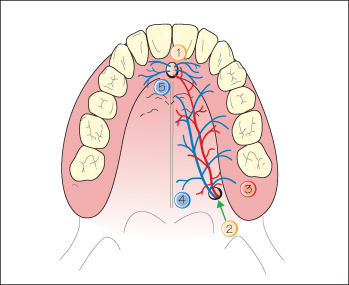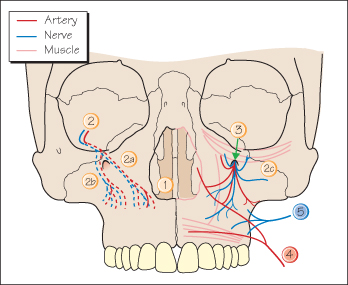4
The basics: surgical anatomy of the maxilla
ANTERIOR AREA
Located between the anterior walls of the maxillary sinus, this area is usually of good bone quality. The region is apically limited by the nasal cavity (Fig. 4.1) that communicates with the maxillary sinus (through the middle meatus). Slight penetration or perforation of the nasal floor may be uneventful.
Figure 4.1 Maxilla: palatal view. 1. Incisive foramen; 2. greater palatine foramen; 3. descending palatine artery; 4. greater palatine nerve; 5. nasopalatine nerves.

The canine region is a strategic area due to mechanical stress dispersion.
The incisive foramen (continuous with the incisive canal) is located between the two medial incisors, slightly palatal (see Fig. 4.1). Its volume can prevent implant placement. Its content is not essential (accessory vascularization and innervation) and can be replaced by a bone graft or substitute to improve the bone bed.
Neurovascular Structures
Buccal (Fig. 4.2 )
Figure 4.2 Maxilla: front view. Right side: intra-bony structures: 1. Nasal cavity; 2. infraorbital artery and nerve; 2a. anterior superior alveolar arteries and nerves; 2b. middle superior alveolar arteries and nerves. Left side: soft tissues structures: 2c. infraorbital artery and nerve branches; 3. infraorbital foramen; 4. facial artery and superior labial artery; 5. facial nerve.

Intra-bony structures:
- infraorbital artery branches: anterior superior alveolar arteries
- infraorbital nerve terminal branches: anterior superior alveolar nerves.
Soft tissue structures (labia/>
Stay updated, free dental videos. Join our Telegram channel

VIDEdental - Online dental courses


